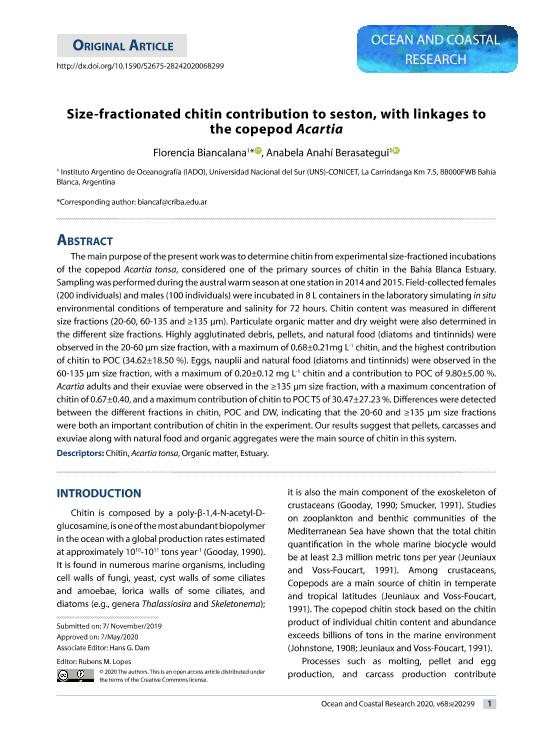Mostrar el registro sencillo del ítem
dc.contributor.author
Biancalana, Florencia

dc.contributor.author
Berasategui, Anabela Anhi

dc.date.available
2021-09-10T16:54:02Z
dc.date.issued
2020-09-18
dc.identifier.citation
Biancalana, Florencia; Berasategui, Anabela Anhi; Size-fractionated chitin contribution to seston, with linkages to the copepod acartia; Universidade de Sao Paulo; Ocean and Coastal Research; 68; 18-9-2020; 1-12
dc.identifier.issn
2675-2824
dc.identifier.uri
http://hdl.handle.net/11336/140111
dc.description.abstract
The main purpose of the present work was to determine chitin from experimental size-fractioned incubations of the copepod Acartia tonsa, considered one of the primary sources of chitin in the Bahía Blanca Estuary. Sampling was performed during the austral warm season at one station in 2014 and 2015. Field-collected females (200 individuals) and males (100 individuals) were incubated in 8 L containers in the laboratory simulating in situ environmental conditions of temperature and salinity for 72 hours. Chitin content was measured in different size fractions (20-60, 60-135 and ≥135 μm). Particulate organic matter and dry weight were also determined in the different size fractions. Highly agglutinated debris, pellets, and natural food (diatoms and tintinnids) were observed in the 20-60 μm size fraction, with a maximum of 0.68±0.21mg L-1 chitin, and the highest contribution of chitin to POC (34.62±18.50 %). Eggs, nauplii and natural food (diatoms and tintinnids) were observed in the 60-135 μm size fraction, with a maximum of 0.20±0.12 mg L-1 chitin and a contribution to POC of 9.80±5.00 %. Acartia adults and their exuviae were observed in the ≥135 μm size fraction, with a maximum concentration of chitin of 0.67±0.40, and a maximum contribution of chitin to POC TS of 30.47±27.23 %. Differences were detected between the different fractions in chitin, POC and DW, indicating that the 20-60 and ≥135 µm size fractions were both an important contribution of chitin in the experiment. Our results suggest that pellets, carcasses and exuviae along with natural food and organic aggregates were the main source of chitin in this system.
dc.format
application/pdf
dc.language.iso
eng
dc.publisher
Universidade de Sao Paulo
dc.rights
info:eu-repo/semantics/openAccess
dc.rights.uri
https://creativecommons.org/licenses/by/2.5/ar/
dc.subject
ACARTIA TONSA
dc.subject
DESCRIPTORS: CHITIN
dc.subject
ESTUARY
dc.subject
ORGANIC MATTER
dc.subject.classification
Oceanografía, Hidrología, Recursos Hídricos

dc.subject.classification
Ciencias de la Tierra y relacionadas con el Medio Ambiente

dc.subject.classification
CIENCIAS NATURALES Y EXACTAS

dc.title
Size-fractionated chitin contribution to seston, with linkages to the copepod acartia
dc.type
info:eu-repo/semantics/article
dc.type
info:ar-repo/semantics/artículo
dc.type
info:eu-repo/semantics/publishedVersion
dc.date.updated
2021-08-19T19:57:50Z
dc.journal.volume
68
dc.journal.pagination
1-12
dc.journal.pais
Brasil

dc.journal.ciudad
San Pablo
dc.description.fil
Fil: Biancalana, Florencia. Consejo Nacional de Investigaciones Científicas y Técnicas. Centro Científico Tecnológico Conicet - Bahía Blanca. Instituto Argentino de Oceanografía. Universidad Nacional del Sur. Instituto Argentino de Oceanografía; Argentina
dc.description.fil
Fil: Berasategui, Anabela Anhi. Consejo Nacional de Investigaciones Científicas y Técnicas. Centro Científico Tecnológico Conicet - Bahía Blanca. Instituto Argentino de Oceanografía. Universidad Nacional del Sur. Instituto Argentino de Oceanografía; Argentina
dc.journal.title
Ocean and Coastal Research
dc.relation.alternativeid
info:eu-repo/semantics/altIdentifier/doi/http://dx.doi.org/10.1590/s2675-28242020068299
dc.relation.alternativeid
info:eu-repo/semantics/altIdentifier/url/https://www.scielo.br/j/ocr/a/FBFZwpvcsVHydwYXT3qVFMR/?lang=en
Archivos asociados
